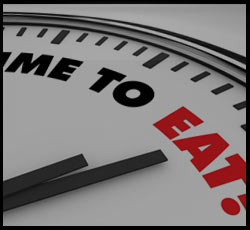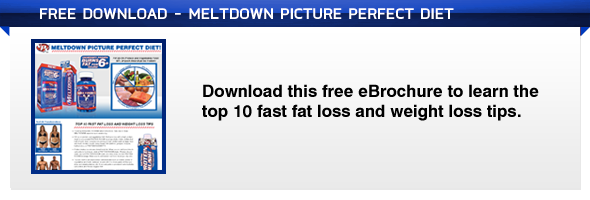
A Discussion of Nutrient Timing and Fluid Intake
*Article 1
So many things in this world are constantly changing and evolving. Just over ten years ago people were dreaming of the future filled with brick-size cellular phones with antennas 8 inches long. Now you can search the web, download and listen to mp3 music, send and receive email, buy movie tickets, book a vacation, listen to a female (or male) voice direct you to your desired location (GPS) all on your cellular phone; and with the slick touch-screen, pushing buttons is a thing of the past. For all we know, the Jetsons weren't so far off. Next thing you know you'll be buying your teenage son the hottest flying car with chrome wings and a booming sound system.
One thing that hasn't changed however is the way the human body (or any mammal for that matter) synthesizes food and nutrients. The food and drink we consume has changed, this is evident by the number of fast-food joints on each corner and the amount of obese individuals walking around the trendiest shopping mall. Regardless of the extremely fat and calorie-laden foods available to us, the only way to control your weight is to control the amount of calories and the timing in which you consume them. It is simple, eat an excess amount of calories and you will gain weight, probably in the form of fat mass. If you create a calorie deficit (i.e. eat less than your body requires) you will lose weight; both fat mass and lean mass (muscle). If you have maintained your weight and body composition you are successfully consuming enough calories for maintenance, thus results are neither weight gain nor weight loss (your weight remains constant).
This brings up an excellent point. By no means is there any one cookie-cutter diet plan that will work for everybody. Some people do well on a low carbohydrate diet, while others feel fatigued and lethargic and yes, gain weight while consuming minimal amounts of carbohydrate on a daily basis. The best distribution of carbohydrate, protein, and fats to optimize performance, improve body composition (fat-free mass vs. fat mass) and achieve a desirable target weight is up for debate. It is not what percentage of these foods you consume that makes a difference, it is how your body responds to the amount of calories you are feeding it throughout the day – Nutrient Timing.
Say for instance your metabolic rate at rest is a mere 1800 calories, but you consume all of those calories in only two meals, you will be consuming a whopping 900 calories in one meal. If this does not sound like a lot to you, maybe we should take a look at caloric content of foods. This is a ridiculous amount of calories to consume in one sitting and will only result in the excess being stored as fat. Your body will use only what it needs at that time, and will store the excess in the form of cottage cheese on your back side.
So, let’s go back to the 1800 calories that your body requires to function normally at rest. Let’s say that you want to lose weight, to do this you’ve got to create a caloric deficit, whether due to exercise or restricting your caloric intake. If you decrease your caloric intake (foods you consume) by an extreme amount without evenly distributing the macronutrient profiles and refraining from physical activity, you will lose weight. But, and that is a big but (pun intended), you are not only decreasing your fat mass, you are losing lean mass as well (in the form of muscle). Muscle is the only metabolically active mass contained in the human body, fat does not require calories to exist. Muscle, however, requires fuel (calories) to avoid muscle catabolism (muscle loss). The less muscle you have, the fewer calories your body needs to function properly. Reducing your daily caloric intake will result in muscle and fat loss thus resulting in a lower metabolic rate. No longer will you require 1800 calories per day, instead, your body may only need a measly 1200 calories per day. So if you have reduced your calories from 1800 to 1500 and now your body only needs 1200 calories, you will gain weight, guaranteed. Not only that, but your body composition has reduced in muscle mass and increased in fat mass – you are now fatter than you were before even though your jeans are loose.
In any case, the ideal situation would be to supply your body with fuel at various times throughout the day. Think back to when your parents were young people consumed three meals per day with a small snack (tea time) between meals. We have already established that the obesity rate in America is higher today than ever before; maybe taking the time for a small snack between meals is not such a bad idea. Here is another great example to help you better understand the scenario at hand, if you are taking a trip in your car that requires 45 gallons of gasoline in total, and your gas tank is only large enough to hold 15 gallons at one time, you have got to refill your tank three times to reach your destination. Either way you still need a total of 45 gallons, so if you were to fill your tank with 45 gallons at once, this obviously would not work and you would have to increase the size of your gas tank to do so. So filling up three times throughout your trip makes more sense. This is the same for your body. Again, back to the 1800 calories your body requires to function properly, if you consume the entire 1800 calories in one sitting, your body cannot utilize this amount of calories at that time and it will have to increase the tank size, in the form of stored fat for use as energy at a later time. Splitting the 1800 calories into five or six small meals throughout the day is a much better way for your body to utilize the energy instead of storing it as fat.
Here is a sample of meal timing (planning):
*for an 1800 calorie diet split into 6 small meals
Meal #1: 7 a.m. – 500 calories total
Meal #2: 9:30 a.m. – 200 calories total
Meal #3: 12:00 Noon – 400 calories total
Meal #4: 2:30 p.m. – 200 calories total
Meal #5: 5:00 p.m. – 300 calories total
Meal #6: 7:30 p.m. – 200 calories total
*This is just an example; caloric distribution can be manipulated in many ways, with breakfast and post-workout meals being of the highest caloric content for the day.
Your first homework assignment is to revamp your day. Get out a pen and paper, write down your schedule (time you wake, work, lunch break, workout, go to bed, etc.) and plan the times at which you are going to have your meals and small snacks. Don’t worry about the percent of each macronutrient (carbohydrate, protein and fat) right now. The important thing at this point is to get your body accustomed to eating more often throughout the day. A good rule of thumb would be to ensure that each meal contains a lean form of protein (ex: Zero Carb Protein Powder) and either “healthy” fats or complex carbohydrate (oatmeal, Ezekiel bread, whole wheat pasta, rice cakes, sweet potato or yams, etc.).
Good luck and happy eating!!!







